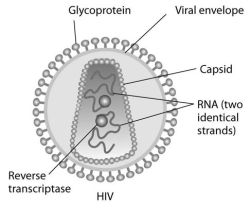Use the following information to answer the questions below.
Human immunodeficiency virus (HIV) infects cells that have both CD4 and CCR5 cell surface molecules. The viral nucleic acid molecules are enclosed in a protein capsid, and the protein capsid is itself contained inside an envelope consisting of a lipid bilayer membrane and viral glycoproteins. One hypothesis for viral entry into cells is that binding of HIV membrane glycoproteins to CD4 and CCR5 initiates fusion of the HIV membrane with the plasma membrane, releasing the viral capsid into the cytoplasm. An alternative hypothesis is that HIV gains entry into the cell via receptor-mediated endocytosis, and membrane fusion occurs in the endocytotic vesicle. To test these alternative hypotheses for HIV entry, researchers labelled the lipids on the HIV membrane with a red fluorescent dye.

-What would be observed by live-cell fluorescence microscopy if the red fluorescent lipid dye-labelled HIV membrane fuses with the target cell plasma membrane?
Definitions:
Shocks
Sudden and often violent disturbances or fluctuations in a physical system, economy, or within a psychological context.
Milgram's Original Experiment
A psychological experiment conducted by Stanley Milgram, which investigated obedience to authority and ethical boundaries.
Maximum Intensity
The highest level or degree of strength, concentration, or force that a stimulus or an activity can reach.
Shocks
Sudden, unexpected events or disturbances that can cause significant changes or adverse effects in a system or organism.
Q15: For living organisms,which of the following is
Q18: In the above diagram,what is the significance
Q52: The coupled G protein most likely interacts
Q56: Which statement best supports the hypothesis that
Q62: This treatment functions under the principle of<br>A)competitive
Q68: The cell membranes of Arctic ice fish
Q73: Reactants capable of interacting to form products
Q79: Cytochalasin D is a drug that prevents
Q81: These protists are intermediate in what sense?<br>A)They
Q83: What is the valence of carbon?<br>A)1<br>B)2<br>C)4<br>D)6<br>E)12